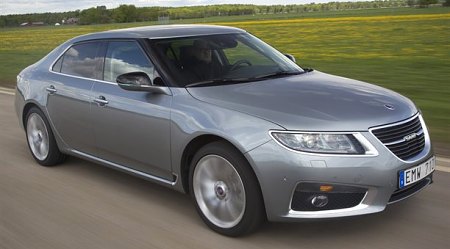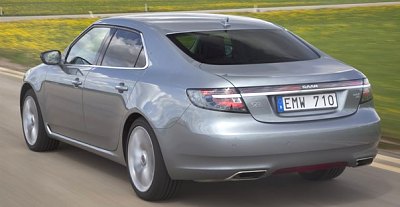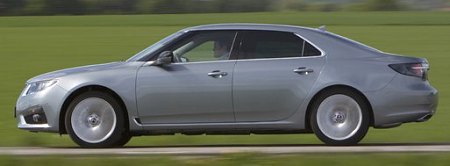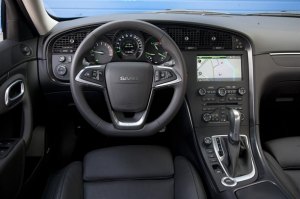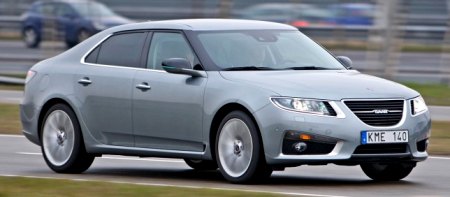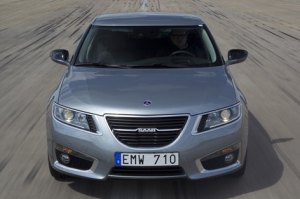Saab 9-5
Debut: 2010 |
||||||||||||
Saab seems to have nine lives. In the past few years, it was declared dead twice by this website – one was made when GM decided to shift its production to Opel; another followed the breakdown of sales talk with Koenigsegg. However, none of them quite materialized. In the end, the Swedish car maker was saved by an unlikely savior, Spyker. Yes, that small and loss-making Dutch sports car maker. You have to admire Spyker boss Victor Muller. Passionate, clever, talkative, handsome and tastefully dressed, he has all the ingredients to fascinate his financial backers as well as motoring journalists who attended the first test drive of new 9-5. His words are so touching. His vision is so great. His determination is so strong. It is easy to forget what made GM struggling to turnaround Saab for years. According to Muller, returning to independence will only do good to Saab - it can decide what's best for itself; it can skip the time-consuming committee decision process; it can even save costs by outsourcing components and engineering from the rivals of GM. However, to make these plans work, first of all the new 9-5 has to take off. Only by achieving so Saab will have the money to invest into its new product plans. The 9-5 is the best present Generous Motors left to Spyker. Everything was already completed by the time Spyker took over the key - development was completed, production equipment were in place, pre-production cars were in the running, even the sales brochures and marketing plans had been finalized. It was a pity that GM could not wait until its launch and see whether it could turnaround Saab. From another viewpoint, however, the 9-5 is probably a deal sweetener. Without it, it would have been difficult to offload Saab.
The new 9-5 is the most "Saabish" Saab since the 9000 of 1985. Although it is based on Opel Insignia platform (aka "Epsilon II"), it is substantially modified such that it neither looks nor drives like the Opel. GM obviously learned the lesson from the current and last generation 9-3, both were closely related to contemporary Opel Vectras hence not very well received by the market. On the new 9-5, some 70 percent of parts are unique. Take the suspension for example, although the basic layout and major castings are common, the Saab gets unique springs, dampers, anti-roll bars, bushings and top mounts to deliver the higher level of refinement it requires. As for steering, it skips the Opel's cheap electric setup for a more naturally weighted hydraulic power steering. Most powertrains are common to Insignia, but Saab has reworked the base 2.0TiD diesel engine for better refinement, added its own twin-turbo 2.0TTiD and specified a more powerful version of the Holden-built 2.8-liter turbocharged V6. The styling of 9-5 is quite successful. Beautiful might not be the best word to describe it, because it combines a unique bland of ice coolness and oddness in the best tradition of Saab. It's not the kind of cars that raise your emotion at first sight, but spend more time with it and it will grow on you. Everything on this car seems different from contemporary design trend - the round nose, the flat bonnet, the chromed headlamp surrounds, the ice-block headlamps, the blackened A-pillars, the sloping roof, the lack of pronounced shoulder lines, the convex fastback and the horizontal tail light bar. They add to the character of the car.
The 9-5 does not pretend to be sporting, unlike many rivals these days. Its shape is by all means civilized, and its long boot is even slightly cumbersome. Under natural sunlight, the car has real presence. It looks substantial and solid, yet there is an underlying sleekness on its surface treatment. The latter is confirmed by the 0.28 Cx. Though derived from Opel Insignia, the Saab is a full class larger, pinching it directly against E-segment players like Mercedes E-class, BMW 5-Series, Jaguar XF, Audi A6, Lexus GS and Volvo S80. Its wheelbase is stretched for 100mm to 2837mm. Its overall length is stretched to over 5 meters, i.e. actually as long as a Mercedes S-class. Factor in the space-saving FF architecture, you get one of the best accommodation of the class. Enter the cabin, you will find ample space for five big guys. Legroom at the back seat is especially generous. Rear headroom is slightly less so, principally due to the rather high-mounted rear seat. In return, seating comfort at the back is close to perfection. The driving position is a surprise. Not only it resembles a jet-fighter cockpit, but it is remarkably close to the design adopted by 9000 a quarter of century ago ! This has pros and cons. On the up side, its ergonomics is great. All controls are positioned logically and within easy reach. On the down side, it looks quite old-fashioned, lacking the air of art and technology of rivals. Moreover, the dark ambience is rather boring. Materials are not especially classy - sure, plastics are soft-touched, but it could use a few more metallic, wood or lacquer trims, or more bespoke switch gears to raise the game.
Though looking dated, this cabin feels adequately sophisticated once it gets into operation - the instrument glows green, the HUD projects digital driving information over the windscreen, and then you discover a switch marked "DriveSense". It is Saab's version of dynamic control system, through which the suspension hardness, steering weighting, throttle response, transmission mapping and stability control threshold can be adjusted. Three modes are provided: Comfort, Sport and Intelligent. The later is pretty clever, as it senses your driving mood and select the most suitable one from a number of preset mappings. Switch to Comfort mode, the ride becomes soft and relaxing. Motorway refinement is superb. The NVH engineering is obvious from the low level of harshness as well as from the mass you can feel. Yes, although all engines are torquey turbocharged units, you won't feel the enthusiasm found on German cars, blame to the 1700-1900 kg kerb weight they need to haul. The all-steel Saab, like other recent efforts from GME, paid a lot of attention to upgrade refinement but without taking any consideration on lightweight engineering, no wonder it is one of the heaviest in the class. This mean the entry-level 180hp 1.6-liter turbo and 160hp 2.0TiD engines can hardly satisfy us. It takes at least the mid-range 220hp 2.0 DI turbo or 190hp / 295 lb-ft 2.0TTiD twin-turbo diesel to feel brisk, thanks to their flexible power delivery rather than outright performance. They are the pick of the bunch for sensible buyers. Comparatively, the flagship 2.8-liter V6 is slightly disappointing. Equipped with a twin-scroll turbocharger and dual-VVT, this engine produces a respectable 300 horsepower and 295 pound-foot of torque, good enough to match a BMW 535i in output count – but not performance, which takes some 0.8 seconds longer to go from rest to 60 mph. Yes, the V6 is smoother and quieter than the four-cylinder engines, and it mates well with the six-speed automatic, but compare with the rivaling engines in this class it is short of outright performance as well as lacking a memorable character.
Moreover, the extra weight at the nose makes the 2.8T slightly less agile than the 2.0T. Admittedly, no 9-5 can be described as agile. It is simply too big and comfort-biased to challenge the German cars for driver appeal. Even if you specify adaptive damping and set the DriveSense to Sport mode, the car is barely adequately sporty. It resists body roll reasonably well without being remarkable. Its steering is adequately firmed up without giving incisive feel. Its throttle is reasonably responsive, but you won't confuse it with a naturally aspirated V8, unlike the case of BMW's 3.0 turbo or Audi's 3.0 supercharged V6. The response of its paddle-shift automatic is not to be confused with the very best ZF auto found on its rivals. To cope with the extra power and torque, the 2.8T is equipped with standard XWD system and rear-wheel torque vectoring (see 9-3 XWD for more details). Moreover, its front suspensions are different from lesser 9-5s bar the equally torquey 2.0TTiD – the conventional MacPherson struts have been replaced with the Hiper Struts of Opel Insignia OPC, whose sophisticated geometry leads to lower King-pin offset thus reduces torque steer. The result is satisfying. Torque steer is undetectable in real world driving no matter how aggressive you push the car. The XWD provides unbreakable traction, and torque vectoring tames understeer very well. Still, the XWD is tuned to enhance safety rather than to simulate a WRC race car. It doesn't change the fundamental character of the 9-5.
Being spacious, plush, refined and tastefully styled, Saab 9-5 is definitely appealing, though not in the German way. It is the best asset GM left to Saab. Now all Victor Muller needs to do is to keep watering the seeds – give it some sensible marketing, rebuild brand image and let the ball rolling. If possible, I would like to see some running changes to trim weight and smart up its interior. With adequate follow-up, it just might survive for another 13 years like the last 9-5, provided Saab is still alive then. |
||||||||||||
| The above report was last updated on 9 Jun 2010. All Rights Reserved. |
| Specifications | ||||||||||||||||||||||||||||||||||||||||||||||||||||||||||||||||||||||||||||||||||||||||
|
||||||||||||||||||||||||||||||||||||||||||||||||||||||||||||||||||||||||||||||||||||||||
| Performance tested by: *C&D |
Copyright©
1997-2010
by Mark Wan @ AutoZine
